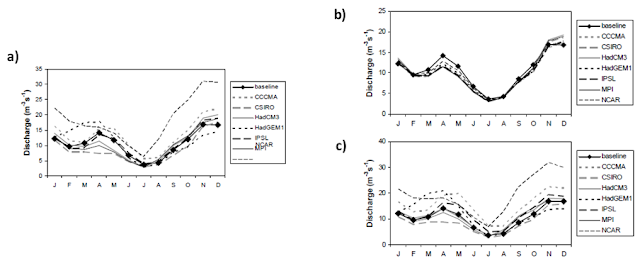For the next 3 blog posts I shall be discussing uncertainty
in predicting freshwater resources under climate change, and the various
sources of uncertainty, with particular reference to the River Mitano in Uganda.
There is a projected intensification of the global hydrological cycle over the
21st century under climate change (strong likelihood; Bates et al., 2008), yet substantial uncertainty remains regarding the impacts of this
intensification on water resources. To predict rainfall, we take evidence from
a multiple GCMs, downscale them using an RCM, apply that evidence to a hydrological
model which then produces multiple estimates (uncertainty) in future
hydrological flows and stores. Substantial uncertainty is introduced at each
stage of this process, and ultimately results in huge variations in river
discharge projections. In this blog post I shall be illustrating this variation
in projections of precipitation and river discharge for the Mitano River Basin
in Uganda, and discussing the associated sources of uncertainty. However it is
important to note that uncertainty in climate change projections of
precipitation does not just affect Africa – it is a global issue.
Kingston and Taylor (2010) modelled the response of the River Mitano in Uganda to a prescribed warming of
2 °C in global mean temperature using seven GCMs. Under these 7 GCMs, the rise
in annual air temperature for the Mitano catchment ranged from approximately
1.8 °C for the NCAR GCM to 2.7 °C for the MPI GCM. However, Figure 1 shows that
the differences between GCMs were much greater for precipitation, with
projected changes in mean annual precipitation over the basin ranging from a
23% increase (NCAR) to a 23% decrease (CSIRO). On a monthly basis, some GCMs
project greater (lower) precipitation in all months whereas other project a mixture
of increasing (decreasing) precipitation over the course of the year (Figure
1b). As such, uncertainty in temperature projections occur mostly from
divergent warming scenarios, rather than GCMs (Cisneros et al., 2014). There is greater confidence in the prediction of temperature than there is in
any prediction of rainfall in the future.
Figure 1. Graphs
illustrating the differences between scenario and baseline a) temperature and
b) precipitation, under the assigned 2 °C warming scenario for 7 GCMs. (Source)
The simulated discharge for the Mitano under the 2 °C
scenario shows these substantial disparities between GCMs, with little
consistency in either the magnitude or direction of change on either a seasonal
or annual basis (Figure 2) (Kingston and Taylor, 2010). For example, the CSIRO GCM projections result in
reductions in river discharge at 2 °C that are greater than those from the
HadCM3 GCM at 6 °C; whereas the NCAR GCM projections result in increased river
discharge in all months that is double that of the baseline in some situations
(Figure 2a) (Kingston and Taylor, 2010). In fact, the seven GCMs used here are drawn from an even larger
population of 23 CMIP-3 GCMS, which, if included, would likely increase the
variation in predicted discharge even further (Kingston and Taylor, 2010).
Figure 2. Climate
change signal in a) monthly; b) annual discharge of the River Mitano under the assigned
2 °C warming scenario for 7 GCMs. a) (Source) (IPCC); b) (Source)
Resolution of the climate change signal for each GCM derived
from temperature and precipitation separately reveals a comparative consistency
in the temperature signal between GCMs (Figure 3a). In contrast, the similarity
of the precipitation signal (Figure 3b) to the River Mitano’s monthly discharge
signal (Figure 3c) clearly indicates that changes in precipitation are the
dominant driver of changing river flow for the 2 °C scenario. Furthermore, the
variation in the precipitation climate change signal between GCMs is far
greater than that for the temperature signal, with different GCMs giving rise
to both positive and negative changes in discharge in all months (Kingston and Taylor, 2010). Thus
variability between GCMs in the precipitation climate change signal, rather
than temperature, is the main source of variability between GCMs in the
discharge signal for the Mitano (Kingston and Taylor, 2010). This is despite East Africa being identified
as a region where there is relatively good agreement between precipitation
projections (Christiansen et al., 2007). This is in agreement with several other authors, including Cisneros et al. (2014) who argue that seasonal
distribution of change in streamflow varies primarily with the seasonal
distribution of change in precipitation, which in turn varies between
scenarios. Both the patterns of change and uncertainty are driven largely by
projected changes in precipitation.
Figure 3. a) Monthly river discharge
climate change signal for the Mitano; b) temperature-only climate change signal
for Mitano; c) precipitation-only climate change signal. All for the River
Mitano under the assigned 2 °C warming scenario for 7 GCMs. (Source)
The
results of Kingston and Taylor’s (2010) modelling of future river discharge for
the Mitano Basin clearly shows that the GCM used to model the effects of
climate change on river discharge is a highly important source of variation
(i.e. uncertainty) between projections of precipitation and thus freshwater
resources. As such, single-GCM evaluations of climate change impacts on river
discharge are likely to be wholly inadequate and misleading (Kington and Taylor, 2010). However, there are other important sources of uncertainty in
predicting future freshwater resources, that I shall discuss further in the
next posts.



No comments:
Post a Comment